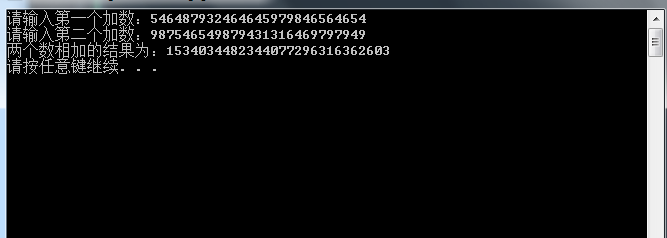方法:这里用了数据结构栈,实际上栈更方便实现高精度加法。
步骤:1、第一个数据加数按输入顺序(高位到低位)入栈1。此时栈顶为最低位
2、第二个数据加数按输入顺序(高位到低位)入栈2。此时栈顶为最低位
3、将栈1、栈2均pop出栈顶做加法,并考虑进位,结果入栈3,这时栈3正好是低位入栈。
4、处理多余的栈1、栈2。
5、直接pop出栈3,即正好的从高位到低位的结果。
完整的实现代码如下:
#include "iostream"#include "stack"using namespace std;stack<int>s1;stack<int>s2;stack<int>s3;char c1[100];char c2[100];int main(void){ printf("请输入第一个加数:"); cin>>c1; printf("请输入第二个加数:"); cin>>c2; int len1=strlen(c1); int len2=strlen(c2); for(int i=0;i<len1;i++) { s1.push(c1[i]-'0'); //按输入顺序(高位到低位)入栈1,此时栈顶为最低位 } for(int i=0;i<len2;i++) { s2.push(c2[i]-'0'); //按输入顺序(高位到低位)入栈2,此时栈顶为最低位 } int tmp=0; while(!s1.empty() && !s2.empty()) { tmp += s1.top()+s2.top(); // 将栈1、栈2均pop出栈顶做加法,并考虑进位,结果入栈3,这时栈3正好是低位入栈 s1.pop(); s2.pop(); s3.push(tmp%10); tmp = tmp/10; } while(!s1.empty()) //处理多余的栈1 { tmp += s1.top(); s1.pop(); s3.push(tmp%10); tmp = tmp/10; } while(!s2.empty()) //处理多余的栈2 { tmp += s2.top(); s2.pop(); s3.push(tmp%10); tmp = tmp/10; } if(tmp) //处理多余的进位 { s3.push(tmp); } printf("两个数相加的结果为:"); while(!s3.empty()) //直接pop出栈3,即正好的从高位到低位的结果 { cout<<s3.top(); s3.pop(); } cout<<endl; system("pause"); return 0;}运行效果图如下:

再分享一下我老师大神的人工智能教程吧。零基础!通俗易懂!风趣幽默!还带黄段子!希望你也加入到我们人工智能的队伍中来!https://blog.csdn.net/jiangjunshow





















 3607
3607

 被折叠的 条评论
为什么被折叠?
被折叠的 条评论
为什么被折叠?








